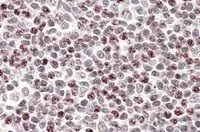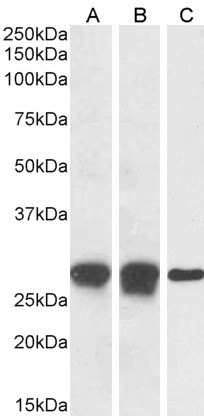
IHC-P analysis of human tonsil using GTX88838 APOBEC3A antibody, Internal. Antigen retrieval : citrate buffer pH 6 Dilution : 3.8microg/ml
APOBEC3A antibody, Internal
GTX88838
ApplicationsImmunoHistoChemistry, ImmunoHistoChemistry Paraffin
Product group Antibodies
TargetAPOBEC3A
Overview
- SupplierGeneTex
- Product NameAPOBEC3A antibody, Internal
- Delivery Days Customer7
- Application Supplier NoteIHC-P: 3-6microg/ml. *Optimal dilutions/concentrations should be determined by the researcher.Not tested in other applications.
- ApplicationsImmunoHistoChemistry, ImmunoHistoChemistry Paraffin
- CertificationResearch Use Only
- ClonalityPolyclonal
- Concentration0.50 mg/ml
- ConjugateUnconjugated
- Gene ID200315
- Target nameAPOBEC3A
- Target descriptionapolipoprotein B mRNA editing enzyme catalytic subunit 3A
- Target synonymsA3A, ARP3, PHRBN, bK150C2.1, DNA dC->dU-editing enzyme APOBEC-3A, apolipoprotein B mRNA editing enzyme, catalytic polypeptide-like 3A, phorbolin-1, probable DNA dC->dU-editing enzyme APOBEC-3A
- HostGoat
- IsotypeIgG
- Protein IDP31941
- Protein NameDNA dC->dU-editing enzyme APOBEC-3A
- Scientific DescriptionThis gene is a member of the cytidine deaminase gene family. It is one of seven related genes or pseudogenes found in a cluster, thought to result from gene duplication, on chromosome 22. Members of the cluster encode proteins that are structurally and functionally related to the C to U RNA-editing cytidine deaminase APOBEC1. The protein encoded by this gene lacks the zinc binding activity of other family members. The protein plays a role in immunity, by restricting transmission of foreign DNA such as viruses. One mechanism of foreign DNA restriction is deamination of foreign double-stranded DNA cytidines to uridines, which leads to DNA degradation. However, other mechanisms are also thought to be involved, as anti-viral effect is not dependent on deaminase activity. Two transcript variants encoding different isoforms have been found for this gene. [provided by RefSeq, Jul 2012]
- Storage Instruction-20°C or -80°C,2°C to 8°C
- UNSPSC12352203




